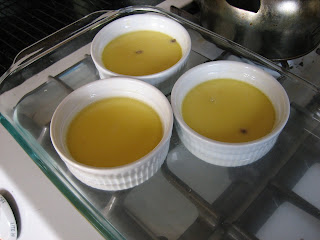
Oh summer: You're so beautiful with your long, sunny days and moderate climes, but why, little tempestuous strumpet, must you plague us with so much squash?! I think my household alone has consumed 1.5 lbs of summer squashes for the last 6 weeks-- oh wait, I'll subtract the pound that I pawned off on some friends recently but still-- that's a total of 8 lbs! Alas, I can't stay mad at you for long, and if anything, my ire will only truly reach fever pitch when your sister autumn comes along with a metric buttload of acorn, butternut, and other winter squashes. Boo.

But let's not talk about that bitch for now (even though she is otherwise my favorite season.) At least this abundance of squash has kept me on my toes trying to find ways I could use it up without having to resort to zucchini bread. In fact, I made it all the way until the 2nd week of August, or I'd guess, maybe the 4th week of squash in the CSA box, before resorting to that default. This squash lasagna may become a summer staple when squash inevitably rains down next year too!
I layered lasagna noodles with a sauteed mixture of yellow squash, zucchini, tomatoes, garlic, and sweet onion and kept this a white lasagna, using only a bechamel sauce and ricotta in order to keep this light and sunny in flavor and color. A bit of basil and lemon zest in the ricotta mixture brightened up the flavors with a citrus zing that cut through the creaminess and cheesy goodness of the noodles. And like all lasagnas, this is great for creating lots of leftovers that you can freeze for packing for lunch or for taking this to a big potluck which I did for one of 2 neighborhood block parties we went to that week.

9 lasagna noodles, cooked according to package directions
2 cups whole milk
3 tbsp butter
3 tbsp flour
dash of nutmeg
1 tbsp olive oil
1.5 lbs mix of summer squashes (yellow and zucchini used here), thinly sliced
1 medium sweet onion, chopped
2 cloves fresh garlic, minced
2 medium tomatoes, slightly squeezed to remove excess juice and seeds, diced
1 15oz container of part-skim ricotta cheese
2 eggs, beaten
1/2 cup grated Parmesan, plus another 2 tbsp
2 tbsp fresh basil, chiffonade
zest of 1 medium lemon
2 cups shredded mozzarella
salt and pepper to taste
Preheat oven to 350 degrees. Cook the noodles according to package directions (I add olive oil to the boiling water to help keep the noodles from sticking) and drain, rinsing under cold water once in the colander.
In the meantime, make the bechamel by melting the butter in a small sauce pan over medium heat. Add the flour and whisk to make a roux. Let this cook for about 2-3 minutes while you whisk it into a light brown paste. Add the milk while whisking, being sure to scrape up any lumpy bits of roux to make a smooth sauce. Turn up the heat to medium high and continue to whisk until the sauce thickens, about 5 minutes. Remove from heat and add about a 1/4 tsp of salt and 1/8 tsp of pepper along with a pinch of nutmeg. Set aside.
Heat 1 tbsp of olive oil in a large pan over medium heat. Add the onion and garlic and let saute gently so that the onions become translucent but don't brown. Add the squash and continue to saute until squash softens and becomes slightly shiny, about 7 minutes. Add the diced tomatoes and cook until tomatoes are just heated so they retain their shape but do not fall apart. Salt and pepper to taste.
Mix together the ricotta, eggs, 1/2 cup Parmesan, basil, and lemon zest with 1/4 tsp salt and 1/8 tsp black pepper. You now have all the components to start layering.
In a large casserole dish, spread 1-1.5 ladles of the bechamel sauce (a skin will have formed while it cooled and thickened, so be sure to stir it up first) over the bottom of the pan. Lay three noodles side by side on this sauce layer. Add 1/2 of your vegetable mix then cover with 1/3 of the remaining bechamel sauce. Dot with 1/2 of the ricotta mixture and sprinkle with 1/3 of the mozzarella. Top with 3 more noodles and repeat as above: vegetables, bechamel, ricotta, mozzarella. Finally, top with three more noodles and pour on the rest of the bechamel sauce and sprinkle with remaining mozzarella and the 2 tbsp of Parmesan.
Cover tightly with foil and bake for about 30 minutes. Remove the foil and continue to bake for another 10-15 minutes or until the top cheesy layer gets some nice brown coloring to it. Let sit for 10 minutes before slicing up and serving.
CSA Count: 5
Yellow squash, zucchini, slicing tomatoes, fresh garlic, basil





 I can't say enough how much I love creme brulee. I love the copper brown sugar crust that looks like stained glass and love even more the cool, silky texture of the custard below. Amelie definitely got it right: taking that first crack at the sugar surface is such a simple pleasure and the moment should be savored.
I can't say enough how much I love creme brulee. I love the copper brown sugar crust that looks like stained glass and love even more the cool, silky texture of the custard below. Amelie definitely got it right: taking that first crack at the sugar surface is such a simple pleasure and the moment should be savored.




 But let's not talk about that bitch for now (even though she is otherwise my favorite season.) At least this abundance of squash has kept me on my toes trying to find ways I could use it up without having to resort to zucchini bread. In fact, I made it all the way until the 2nd week of August, or I'd guess, maybe the 4th week of squash in the CSA box, before resorting to that default. This squash lasagna may become a summer staple when squash inevitably rains down next year too!
But let's not talk about that bitch for now (even though she is otherwise my favorite season.) At least this abundance of squash has kept me on my toes trying to find ways I could use it up without having to resort to zucchini bread. In fact, I made it all the way until the 2nd week of August, or I'd guess, maybe the 4th week of squash in the CSA box, before resorting to that default. This squash lasagna may become a summer staple when squash inevitably rains down next year too!
